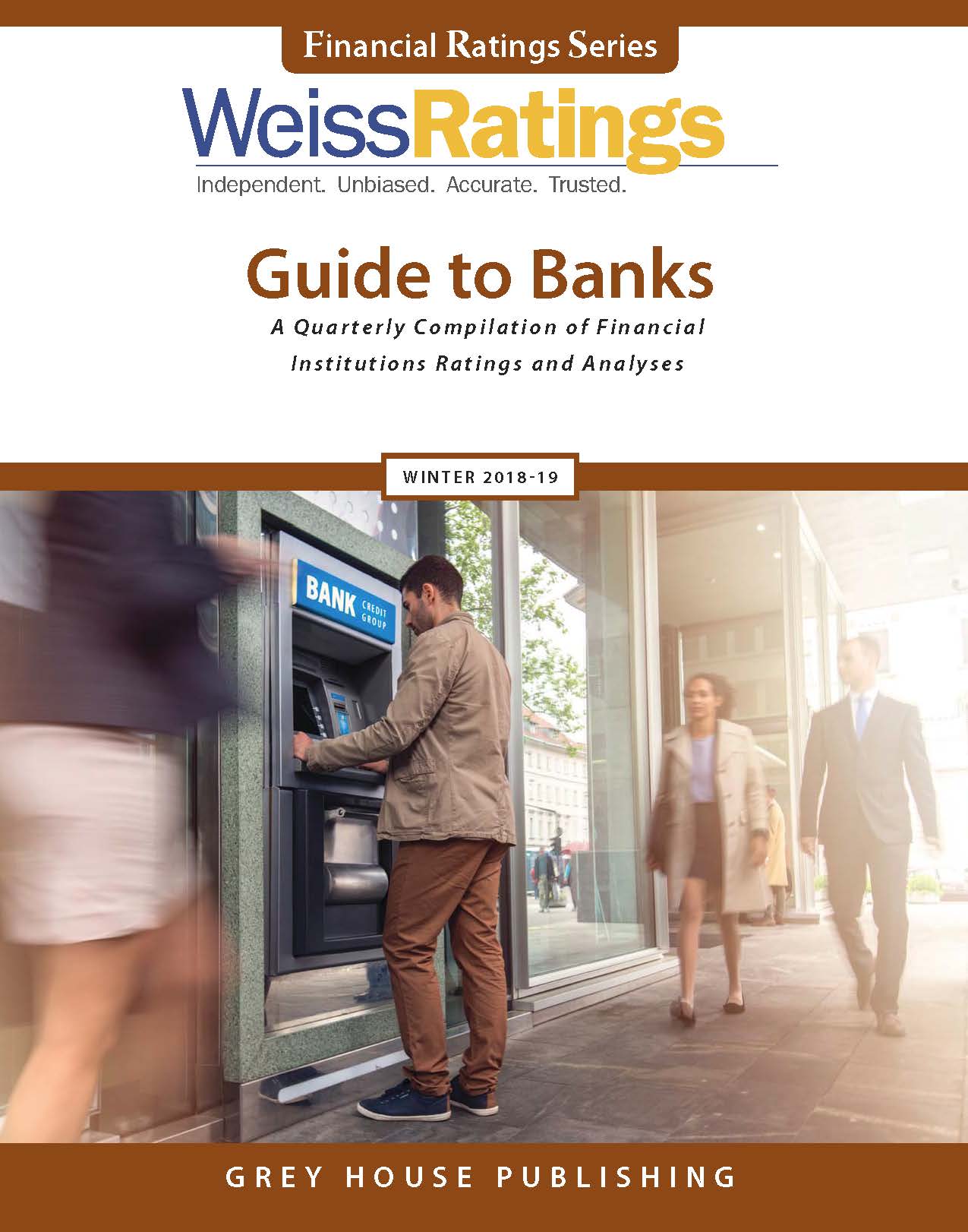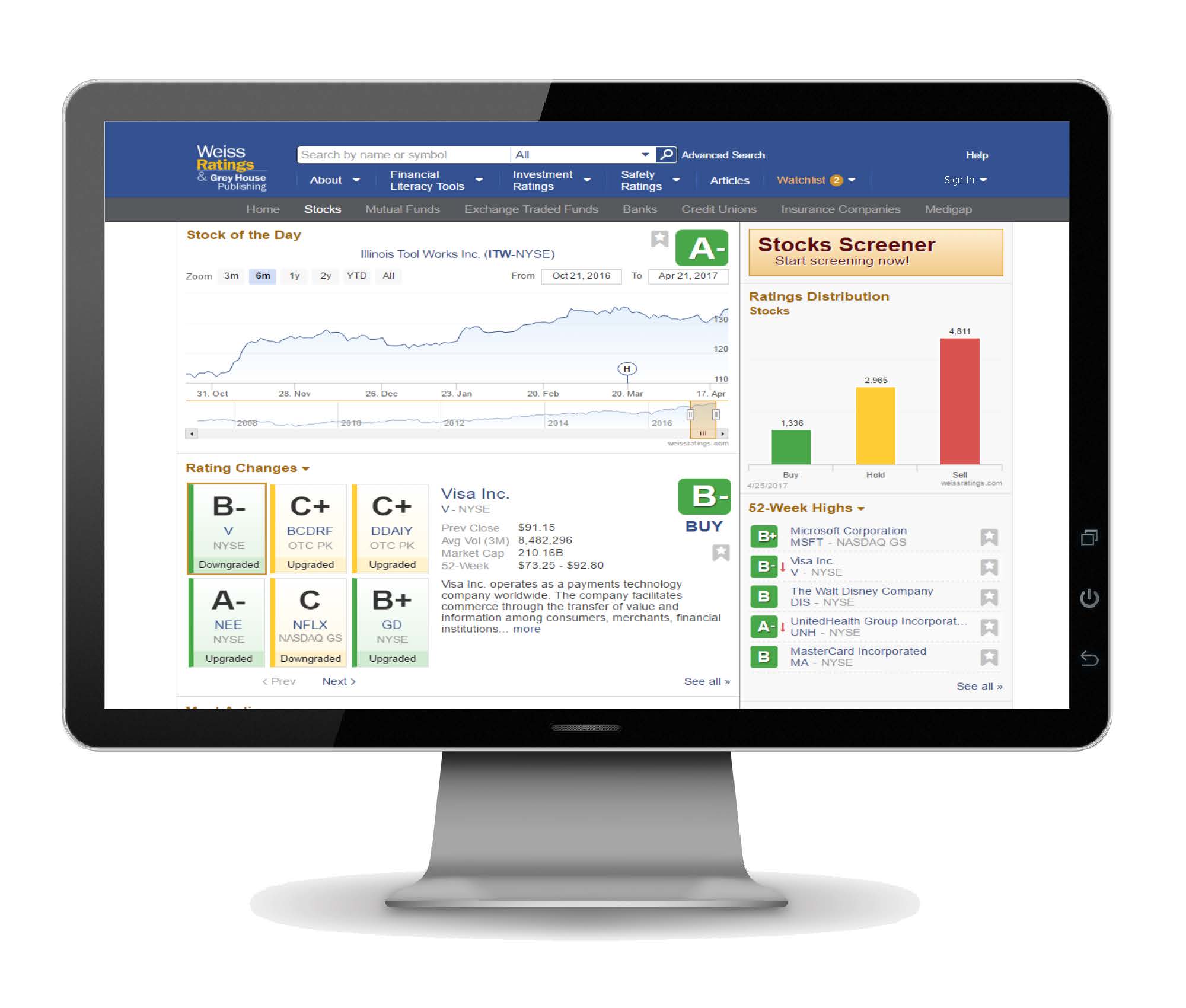
-ARBA
Softcover: 300 pages
Price: Four Quarterly Editions $549
Single Issues: Winter, Spring, Summer, or Fall

Price: Single Edition $279

NEW ONLINE DATABASE PLATFORM!
www.greyhouse.weissratings.com
Financial Ratings Series Online combines the strength of Weiss Ratings to offer the library community a single source for financial strength ratings and financial planning tools covering Banks, Insurers, Mutual Funds and Stocks.
This powerful database will provide the accurate, independent information your patrons need to make INFORMED DECISIONS about their financial planning.
Call (800) 562-2139 to get a Free, 30-Day Demo of the new Online Database!
Weiss Ratings’ Guide to Banks is the ideal resource for accurate, unbiased ratings and data to help citizens across the U.S. choose a commercial bank, savings bank, or savings & loan for themselves, their families, their companies, or their clients.
Most people automatically assume their bank will survive, year after year. However, in this world of shifting risks, no financial institution is certain, and a bank’s failure could cause lost money, lost time, tied-up deposits, dropped credit lines, and the transfer to another institution under not-so-friendly terms. Luckily, Weiss Ratings’ Guide to Banks gives both novice and experienced bankers the tools they need to survive in today’s shifting economic market.
Grey House’s Financial Ratings Series combines the strength of Weiss Ratings and Grey House Publishing to offer the public a single, comprehensive source for financial strength ratings and financial planning tools. From health insurers to banks and credit unions to stocks and mutual funds, the Financial Ratings Series provides accurate, independent information that consumers need to make informed financial decisions.
All of Weiss Ratings’ Guides are published quarterly, utilize a clear-cut A-to-F rating system (similar to school grading systems), and contain more complete, up-to-date ratings than any of their competitors. These 2018 editions of Weiss Ratings’ Guide to Banks features ratings and analyses of over 8,500 U.S. commercial banks, savings banks, and savings & loans. Many of these companies are not rated anywhere else.
Weiss Ratings’ Guide to Banks is divided into three sections, preceded by an introductory section and followed by a thorough Appendix. Weiss’ complete letter-grade rubric is detailed on the inside front cover—an easily accessible reference for users researching companies in this guide.
The introductory section begins by welcoming the user and laying out the mission statement, followed by a “How To Use This Guide” orientation to the book. The final components of this section are an explanation of the Financial Strength Ratings used in the book and a page of important warnings and cautions for the user to take into account when evaluating banks.
Section I is an Index of Banks. This section contains Financial Strength Ratings, Key Rating Factors, and summarized financial data for all U.S. federally-insured commercial banks, savings banks, and savings & loans. Companies are sorted in alphabetical order, first by company name, then by city and state.
Section II contains a Recommended Company List. This is a list of companies receiving a Financial Strength Rating of A+, A, A-, or B+. Recommended institutions are listed in the state in which they currently operate one or more branches, and then organized alphabetically by city.
Section III is a list of Rating Upgrades and Downgrades that identifies those institutions receiving a rating change since the previous edition, whether it be a rating upgrade, rating downgrade, newly rated company, or the withdrawal of a rating. Each listing contains the Institution’s Name, New Financial Strength Rating, State, and Date of Change.
The guide ends with an Appendix containing three sections: a list of Recent Bank Failures, a detailed chart called “How Do Banks and Credit Unions Differ?”, and a Glossary containing the most important terms used throughout the publication.
ONLINE SUBSCRIPTION
Weiss Ratings’ Guide to Banks is also available for subscription as part of the Financial Ratings Series Online, giving users the tools to discover the best, most financially stable organizations in business today. Using a quick and easy search screen, subscribers to the online database will have access to Financial Strength Ratings for more than 21,000 Banks, Credit Unions, and Insurance Companies (Auto, Life, Health, and Homeowners’), as well as Investment Ratings for over 6,000 Stocks and 16,000 Mutual Funds. Additionally, subscribers will have access to individually customized Medigap Buyer’s Guides, a Long-Term Care Insurance Planner, a Ratings Track Record, and many other financial planning tools. Visit www.greyhouse.weissratings.com for subscription details.
Weiss Ratings’ Guide to Banks presents the most comprehensive, accurate, and independent analyses and ratings of U.S. banks in an accessible format, so users at any level can easily navigate through this incomparable resource. Since the guide is published quarterly, the information and ratings react quickly to changes in the industry, and users can rest assured that all ratings are up-to-date.
Weiss Ratings Guides
Weiss’s rating scale is extremely straightforward and easy to understand. There are no complicated number grades to interpret, no colored paper to decode, and no stars to count. Instead, each entry gets a simple, intuitive letter grade that immediately identifies the wheat from the chaff. This is one more reason why Weiss Ratings is widely recognized as "America's Consumer Advocate for Financial Safety." The Weiss Safety Ratings have been proven to be the most accurate available from any of the major rating agencies. Plus, unlike the other major rating agencies, Weiss does not accept compensation from the companies it rates, and thus does not allow companies to influence the ratings they receive or to suppress the release of their ratings. In fact, the U.S. General Accounting Office (GAO) validated Weiss’ accuracy in its Insurance Ratings study, and that same superior rating methodology is used when deriving all other ratings as well.
Annual Subscription
Softcover: 300 pages
Price: Four Quarterly Editions $549
Single Issues: Winter, Spring, Summer, or Fall

Price: Single Edition $279
Also Available:
- Financial Ratings Series Online
- Weiss Ratings Consumer Box Set
- Weiss Ratings Investment Research Guide to Bond & Money-Market Mutual Funds
- Weiss Ratings Investment Research Guide to Stocks
- Weiss Ratings Investment Research Guide to Exchange-Traded Funds
- Weiss Ratings Investment Research Guide to Stock Mutual Funds
- Weiss Ratings Guide to Credit Unions
- Weiss Ratings Guide to Health Insurers
- Weiss Ratings Guide to Life & Annuity Insurers
- Weiss Ratings Guide to Property & Casualty Insurers
Note: If you find this work does not fit your budget, please print out this page and bring it to your local library. There is a reasonable chance they either have a copy, can direct you to a library that does, or will be willing to purchase it for their reference collection.